Kenworth‘s hard man at the head, Patchell Industries bearing the load, and local talent at the tiller – it would appear Self Loader Logging Ltd has no problem separating the wood from the trees along the hallowed carriageways of the mighty Kaingaroa.
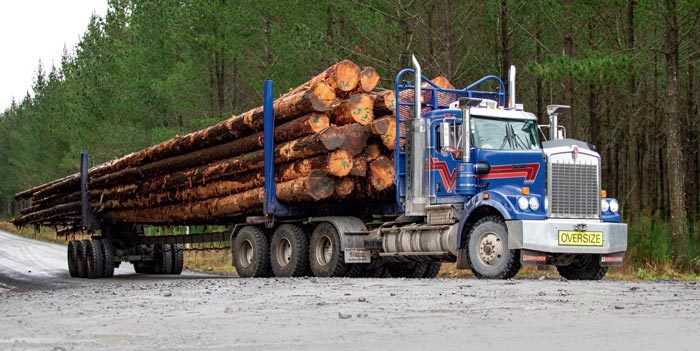
Damn! It‘s raining,” said Carl. “It‘s July, and plus, it‘s Kaingaroa,” I replied. “It does its own thing weather-wise, whatever the time of the year. It‘s all part of the mystique.” ‘Mystique‘ is not too romantic a word to describe Kaingaroa, be it the 1829-square-kilometre forest, the people who have made their living there, or the machines … oh the machines. For truck enthusiasts, Kaingaroa has Elysian qualities, a pilgrimage destination, not just for locals, but truck spotters the world over. Pacific, Kenworth, Mack, Western Star, and even Scania have each sent their biggest and best into this green world where VDAM, as the outside knows it, is left at the gate. Off-highway forestry is in a class of its own. Then there‘s the roadscape. Truck driver or not, few New Zealanders will ever see or experience the vast roading network that has beaten many a machine to the point of submission. High Level, Low Level, Pekepeke, Waihu, Bonisch, Goudies, Wheao, and Wairapukao, are as much a part of roading folklore in New Zealand as any of the famous highways that exist beyond the forest‘s outermost trees.
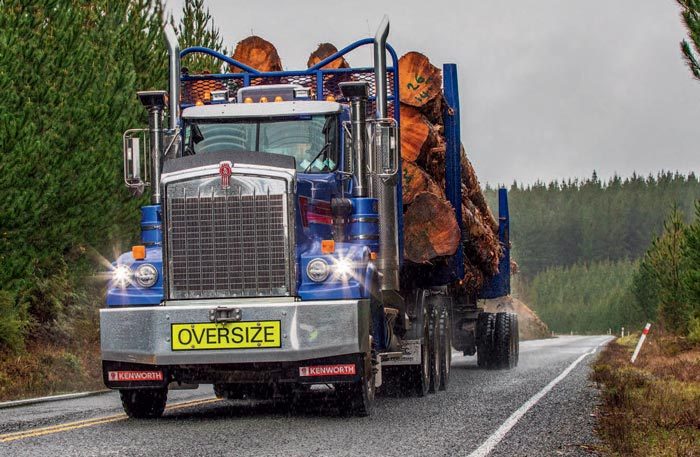
Photo: Cresting Wairapukao hill.
At this point it would be customary to say ‘but it‘s the people who bring life to the roads and the trucks that ply them‘. But here it‘s more than that, it‘s far deeper. What makes Kaingaroa, and Kinleith for that matter, so special is they are living things in their own right. Millions of living entities all contributing to the whole. The trees are the tissue, the roads are the arteries, the trucks are the blood cells, the towns and mills their vital organs, and the people their DNA. Were it all gone in an instant, would we grieve a loss beyond jobs and commerce? Absolutely. That analogy explains so much; it brings clarity. Kaingaroa is not just a nursery for pine trees, it‘s also a nursery for the right kind of person. Growth is about opportunity, making the most of where you are and striving for the light. For some, Kaingaroa has brought opportunity where there may have been none, and they have thrived as a result. The forest has nurtured according to her own requirements, none more so than in the cabs of her trucks. The off-highway has no place for haste, erratic acts, or impulse. The ability to bring countless huge loads in for processing over many years with the deftest of touches and unflappable demeanour is the reason those of the ilk of Olsen, Calteaux, Higgins, Hepi, and Blyth will resonate in the pages of New Zealand‘s trucking history forever, deserved of the highest honours and utmost respect.
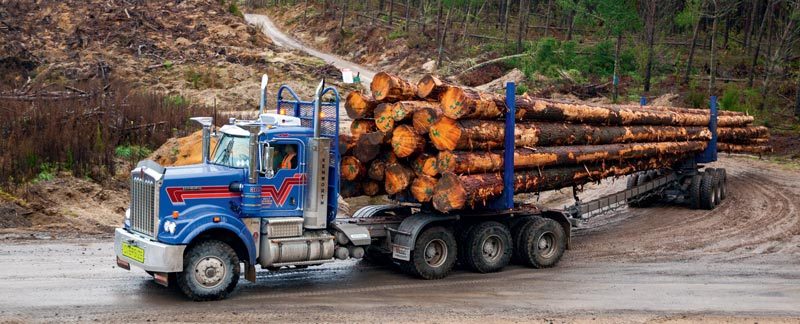
Hard act to follow
So here we are, in the privileged position of having been granted access to Kaingaroa in order to check out the latest in stem carting creations recently commissioned by Bryan Smith‘s Self Loader Logging Ltd. Bryan‘s been involved in carting logs from the giant central North Island plantations for more than half of their almost 70-year harvesting life. Cranes, highway loggers, heavy haul, bin-wood and off-highway cartage; he‘s done it all. There are few who know what it takes to survive and thrive in the game better, so when he decided it was time to retire a couple of his aging Western Star stem trucks, we were keen to see what turned up. “The first thing I want to say is the Stars were bloody good trucks. They‘ve got fullwidth cabs, great visibility, access, and ride well. The drivers love them. I don‘t change suppliers without good reason, and the truth is, Western Star couldn‘t supply the engine we needed in terms of emissions and power in their off-highway truck chassis. We tried, believe me we tried, but just couldn‘t get it over the line. “The Kenworths? Nothing wrong with them, don‘t get me wrong, we run them also, but it wasn‘t a case of the Western Stars not being up to it, they‘ve been really good trucks. Penske has stood by them and Peter Motzyoloski has been nothing short of brilliant to deal with. It was just a case of not having what we need, and Adam [McIntosh – Southpac] did.” From that, you‘ve got the answer to the question we asked above. It was Kenworth that won the order number for the Western Star replacements, and Bryan‘s opening comments that the Stars will be a hard act to follow was a recurring theme throughout the couple of days we were in camp, both from Bryan, his general manager Tony Golebiowski, and the drivers we spoke to.
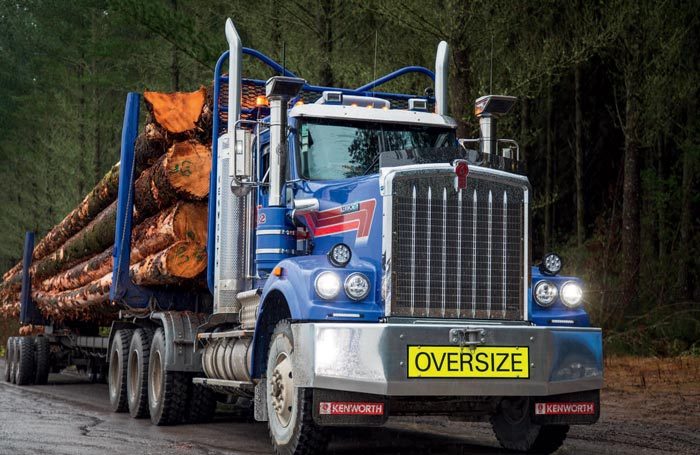
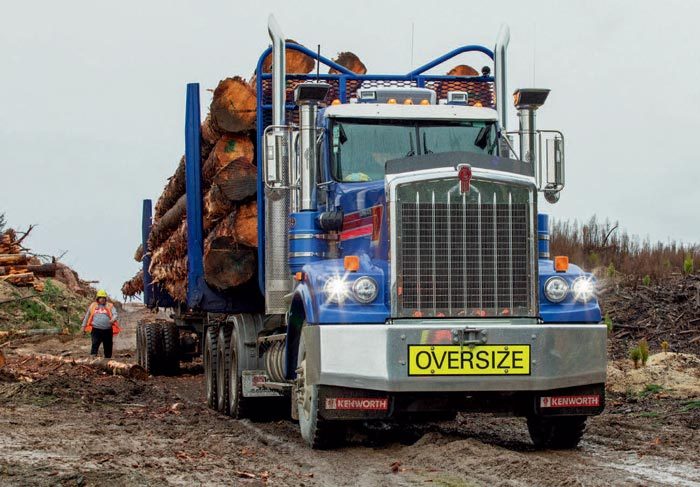
Photo: Spot the difference. Pretty much fleet numbers and the spot lights on Glenn‘s guards.
Taking the stage
If you want to chase a tough Western Star with a tough Kenworth, then the C509 is your go-to guy. In last month‘s Aussie Angles section, talking about outback cattle cartage, RTA‘s Glen Smith cited the C509 as “the perfect bush truck”. You might ask why an Australian reference? Because C5s are built to cart multitrailer loads over 100-tonne GCM in the hardest country, where tare is not the prime consideration. Those criteria aren‘t overly common here and speak volumes for what goes on in Kaingaroa, home to New Zealand‘s highest concentration of C5 series Kenworth trucks. Rotorua Forest Haulage, Williams and Wilshier, Self Loader Logging, and Graves Log Transport all run C5s in their off-highway stem fleets. “Rails. Big rails, that‘s why we chose the 509,” said Bryan. “The original Stars on stems needed strengthening, so do the Kenworth 909s. They‘re just not up to stems work stock standard. Even in saying that, we still prep everything with extra bracing before it goes on the road, regardless. Yes, the 509s might be fine, especially with the smaller hangers on the 38-tonne suspension, but it‘s a shit-load cheaper to prepare than it is to repair. Re-railing a truck is a really expensive job, and not something you want to be doing very often. “The 509s are bloody expensive, but in saying that, they‘re a lot of truck.” We may rely on our ANZAC whanau to build our tough trucks, but when it comes to bearing the load over the rails and out back, it‘s all homegrown. No country will ever boss New Zealand around when it comes to putting a log on a truck, and in terms of grasping the forest‘s invitation to prosper, Ian Patchell stands among the tallest. Milk Arrowroot biscuit and a cup of tea, a sausage wrapped in white bread. Two Kiwiana beauts! In terms of log truck combinations in Godzone, a Kenworth truck with Patchell log gear is a comparative association. “Yep, Patchell right through for stems,” said Bryan. “Again, it‘s not bloody cheap, but they stand by their gear. Pete [Elphick] is a top bloke, and it‘s good gear.”
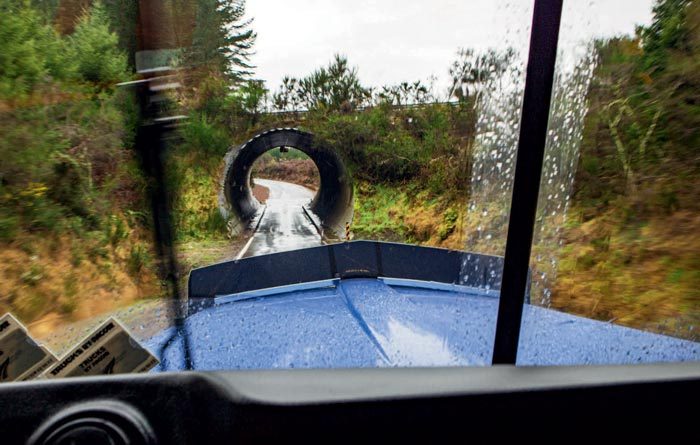
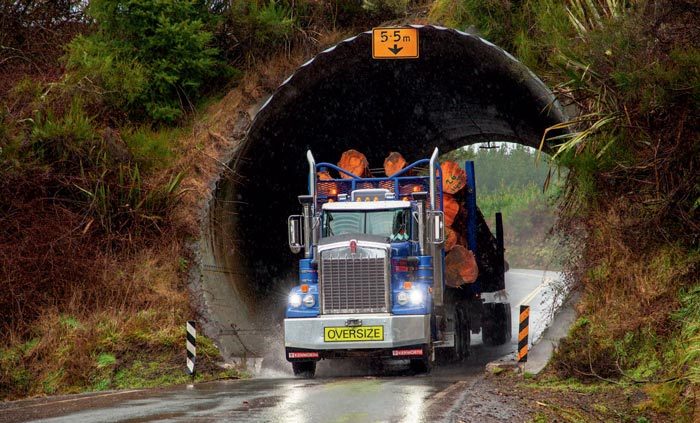
Photo: Through the State Highway 38 underpass.
“A lot of truck”
Tony Golebiowski drew the short straw of chaperoning a ute-load of raving truck-heads into paradise. A flick of the indicator just out of Broadlands saw the Colorado turn up Tiriti Road, an innocent looking corridor, but one that eventually intersects with the fabled High Level Road. Before that junction though, something appeared out of the drizzly murk, “There it is!” It was the unmistakeable shape of a Kenworth C509 stems unit parked up on the side of the road, waiting… for us! We pulled over to the side and jumped out to find 11-year stem carting veteran Duncan Herewini having a glance over his new charge just a week into its life. As we stood there breaking the ice, a pair of flashing beacons appeared in the distance. “Here‘s Glenn now in the other truck,” said Duncan, and before we knew it, we had them both idling away beside us. Self Loader Logging 309 and 312, the two newest stem trucks in Kaingaroa. Glenn Wilson drives 312 in a four-on four-off roster with Brad Stilwell, and it was only on its second day of operation. As such it was all very new. The cab width and access weren‘t rating highly with Glenn and initial thoughts were that the ride was harsher than the Western Star he‘d got out of. Duncan endorsed Glenn‘s thoughts, but being a week in, he was becoming increasingly settled with his charge. “It‘ll take a while to suss it out, eh,” said ‘Dunks‘, as he‘s known. The initial impact is the cleanliness of the rigs, meaning absence of ‘stickyout‘ unnecessary bits, and in concert with that the fact they‘re built like a brick privy. Behind the cab guard the tractors are completely plated and protected, and aside from a quarter guard, the mud guards are the uber-cool Aussie style heavy rubber on spring hooks. In the distance aft, the Patchell Tridem Ultimate log trailer is devoid of anything it doesn‘t need – that includes guards, for reasons that became obvious soon after. You might think it would give them a bland look, but with the decorative accoutrements forward of the log frame, and Self Loader Logging distinctive blue bolsters and grey chassis, they are anything but. Chat over, Glenn‘s bonnet lifted as the Cummins, Roadranger, and tri-drive Meritor setup overcame the inertia and got 80 tonne of logs, truck, and trailer under way. Back in 309, Dunks picked up the bush radio and made the kind of call that‘s echoed in the trees for decades: “Empty stem off Tiriti onto Road 1 heading for Road 4.”
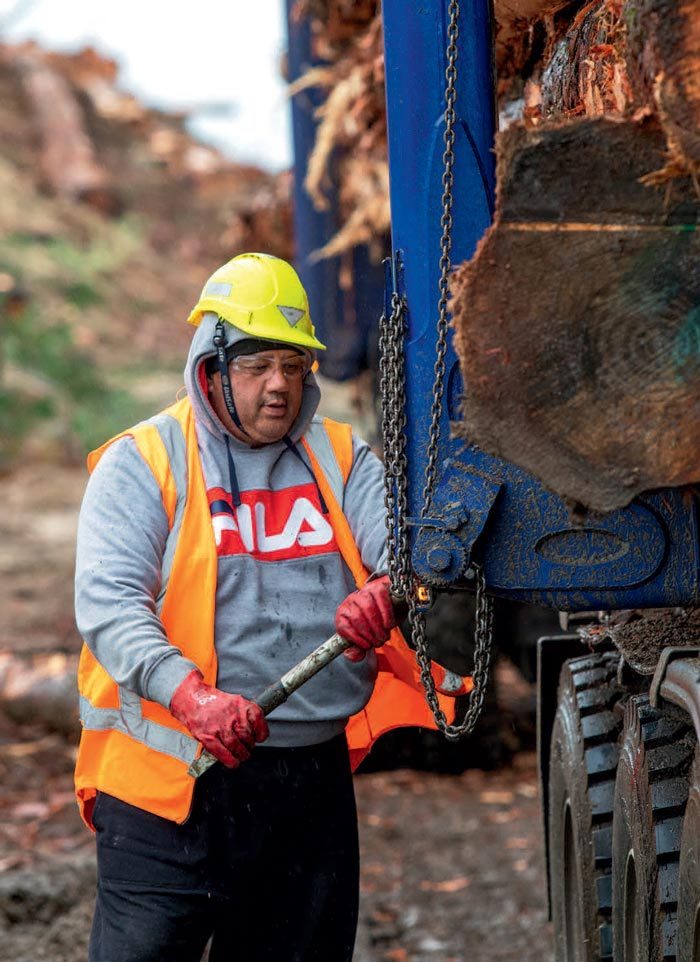
Photo: Dunks, looking every bit the 2020 log truck driver, tends to the load prior to lift-off.
Stemming the flow
For those new to the game, a stem is pretty much a whole, limbed tree, of around 28m in length. Known as the Kaingaroa Processing Plant (KPP), the Webb Road facility near Kaingaroa village opened in 1995, its role to consolidate log processing, reduce the amount of on-skid work required, and slash highway truck traffic in the forest. That last point was a two-way benefit. Grabbing your load from the Webb rather than blazing around the vastness of Kaingaroa certainly affects what can be done in those precious 13 hours you‘re not allowed to be tired. In doing all of the above, the Webb birthed the dedicated stem truck concept in Kaingaroa. A fleet of specialist trucks able to cart stems from the bush skids in for processing. Rotorua Forest Haulage‘s Sargison family pioneered the dedicated stem cartage operation and still hold the master contract, with Williams and Wilshier, Self Loader Logging, and Graves Log Transport sub-contracting to them. “Where the stems are today is all down to so much grassroots work done by Colin and Tony [Sargison],” said Bryan. “Payloads today are limited to 65 tonne, and that‘s governed by what the Wagner at the Webb will comfortably lift.” Dunks eased the 509 into position alongside the load-out site on the skid. The modern log skid, particularly here, is a ghost town compared with years gone by.

Photo: The obligatory weigh-in.
Once a hive of people dropping trees, measuring, spraying paint, and cutting, today it looks like a scene from a sci-fi movie, with machines inching their way around the forest compartment (the name given to specific blocks of trees), doing all the felling, limbing, and loading, their operators safely behind a ROPS framework. Back to the clean simplicity of the Patchell trailer – here‘s why. On a right-side load-out, the loader grabs the stem close to the butt end and lifts it so the log lies on the trailer bolster about two-thirds the way down its length. The operator then pulls the butt in a low arc over the left side using the bolster bed on the trailer as a fulcrum to lever the tail up. They then place the butt, setting it down on the front bolster bed. Easy! So smooth to watch. The technique keeps the logs away from the vehicle mechanicals as much as possible, and right to the last few seconds an errant log slipping from the grapple will likely fall harmlessly on the ground to the left with the tail still in the trailer bolster/ stanchion. The technique also ensures the log is grounded at one end all the time. As impressive and safe as it is, it does means stainless guards and running lights will never be part of a stem trailer options box. The one concession to vulnerability on the trailer is the small tail light.
Making tracks
Loaded, chained and ready. Drizzly but far from cold. Dunks jumps in, selects second low, and with the locks in, he engages the clutch. The 509‘s bonnet gives a shudder as the three big ‘screws‘ under the butt end of the load start making tracks in the mud. “Loaded stem on Road 4 for heading for Tiriti.” Neither of the trucks is set up with central tyre inflation, something that‘s generally considered standard fit nowadays in a roving highway log truck. “We tried it on stems, not for traction though, with tridrive and the terrain out there it‘s not really needed for that,” said Bryan. “It was more an inflation management thing, saving cases, but it doesn‘t work with the 13R tyres. They‘re big lungs, and it just couldn‘t keep up when one goes down. And you‘ve got 12 of them remember. Trying to stand a loaded stem up if it‘s gone a bit sad on the side of the track with tyres off the bead is not fun.” On the turn out of Road 4 onto Tiriti the truck offered a mild demonstration of the stem unit party trick: sledging. Twenty-six, 28m logs on a tridrive off-highway chassis in greasy conditions can mean the solitary steering axle up front may need all the help it can get in order to coax the unit into a change of direction. That help can only come from Dunks, and upon reaching the end of the road he guided the big Kenworth around with minimal fuss. “Yeah, you have to be careful of them, they‘ll want to go straight ahead in certain conditions. Today is those conditions,” he chuckles.
It‘s one of the reasons Bryan goes for the big 13R feet, and both he and Dunks believe they make a real difference. They also give the Smith trucks a bigger, ‘chunkier‘ look. Once on Tiriti the 509 starts making progress as Dunks works quietly through the gears. His is a driving style not really taught but inherited. It‘s obvious from the get-go his ear for what an off-highway log truck should sound and feel like was ingrained as a young fella growing up in and around the KLC workshops in Murupara, and spending precious time with the likes of his uncle, Vern Higgins. Off Tiriti and onto the High Level Road, then Waihu as High Level swings away left. Waihu‘s a long, gradual descent to the Low Level Road. Interestingly there‘s no blazing roar of the engine brake, more a gentle controlled glide. The engine‘s nowhere near max rpm; it‘s sitting in the upper mid-range, around 1700rpm, easing it all down gradually. For Dunks it‘s all feel, and his style, like all the good heavy load practitioners, is about conducting energy, knowing who owns it at any one moment, whether it‘s the load or the truck. Coming down Waihu he knew the potential energy in the load was immense and best not to let it out, then have to wrestle it back with a howling Jacobs and hot brakes. He‘s concentrated and you know he‘s reading the situation by sensing what the truck‘s telling him.
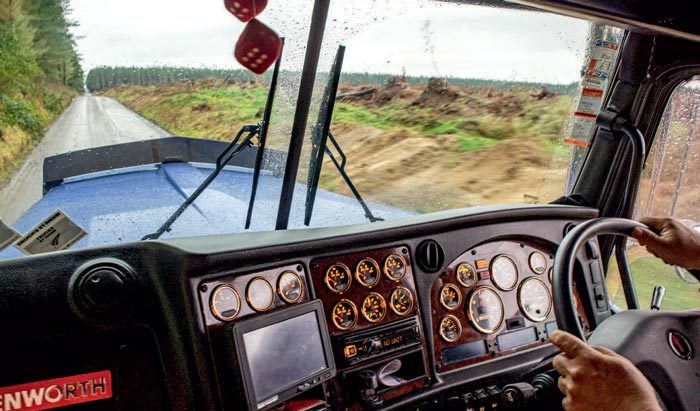
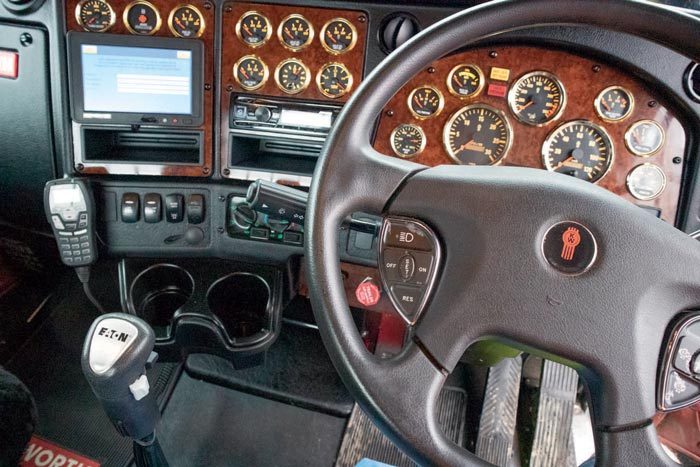
Photos: Well-built and everything is within half an arm‘s length. A great operator‘s ‘possie‘, but the ‘snugness‘ of the narrow cab dates it in 2020. Bring on the 2.1m in the big-boppers! Below: The Wagner lift capacity governs the payload the stem trucks carry. Mind you, 65 tonne‘s pretty handy.
Although the Jacobs in the X-15 is a good friend to have in this style of operation, with strong mid-range retardation (392kW (525hp) at 1700rpm), Dunks said he had a BrakeSaver in a previous ride and rated it a great tool in the quest to control lots of mass on wheels that‘s aiming downwards. Our mind went back to our chat with Bryan the day before. “A good driver can put years on a truck‘s life, or take years off it. It‘s that significant.” We reached the compulsory stop at the bottom of Waihu Road. Not the best designed corner, the stop sign is on a sweeping curve and intended to be the off-highway truck‘s friend, but the placement of the sign means on a stem truck the huge butts can just obscure the sight line back up the road. Dunks rolls up slowly and then has to adjust a tad more before stopping. “It‘s a bugger this one, hard to see the way it is. See, there‘s a truck coming.” “Loaded stem off Waihu onto Low Level heading for Wairapukao.” Then the driving style changes, the greasy gravel roads are gone, it‘s now bitumen underfoot. It‘s a lift-off from a flat start into a gentle rise and now Dunks owned the energy, and he had a load to get moving. The X-15 is a different beast entirely, pouring every ounce of power and torque it can muster back to the drive units. Dunks‘s smoothness doesn‘t alter one iota; it‘s hard to believe this man‘s only been in the truck a week. Each time the needle hits 1950rpm, he picks off another gear from the 18-speed manual Roadranger, crisp as you like. This lift-off is about power and impetus. “It gets up and goes when you want it to, this thing, and hangs on too,” he says. Yes, bitumen. You read right. For those who don‘t know a lot about the offhighway‘s main arterial routes, in terms of surface, markings, and signage, you‘d be hard pressed to pick them from a state highway … actually you could, the off-highway arterials we saw were in better nick.
To be fair, three things would make any ‘little lamb lost‘ twig they‘d taken a wrong turn. One would be the endless trees, two would be the nice Timberland‘s inspector asking what it was they were doing, and three, the ‘ginormous‘ trucks… not that most Kiwi drivers see trucks at the best of times. The rules in here are nonnegotiable, and there‘s little tolerance for violation. For a loaded stems unit 80kph is it, but that‘s no issue, as there simply isn‘t the constant and underlying time tension that haunts the lives of truckers in the rat race. Forest time is safe time. Up to speed it‘s all calm and comfortable motoring. The bolsters on the unit are two different sizes, 3.1m outside to outside on the truck, and 2.5m on the trailer. The differential came about due to the butt-forward nature of the loads, and the width of the trucks‘ bigger unit determined by the roads outside the bush, meaning the trucks can come into town for maintenance and not need a pilot. Climbing hard into the Wairapukao Road hill (lower St Stephens Hill, maybe) the Kenworth held 5th low, at 1500rpm and 30kph. Then it was through the famous SH38 underpass and down to KPP Webb Road for unloading. There aren‘t many Wagners left in active service nowadays, only in strategic places like KPP. Big and ungainly they may appear, and from all accounts not the easiest beast to see out of in terms of locating the spears, but when it comes to lifting 65 tonne of stems off a puny truck in one hit, the L130F Wagner would have few peers. And ‘puny‘ is no disrespect to the 509. Like a big mine, Kaingaroa is an attack on the senses in terms of scale, and when the L130F rolled up, the C509 turned into a Fun Ho! Midget.
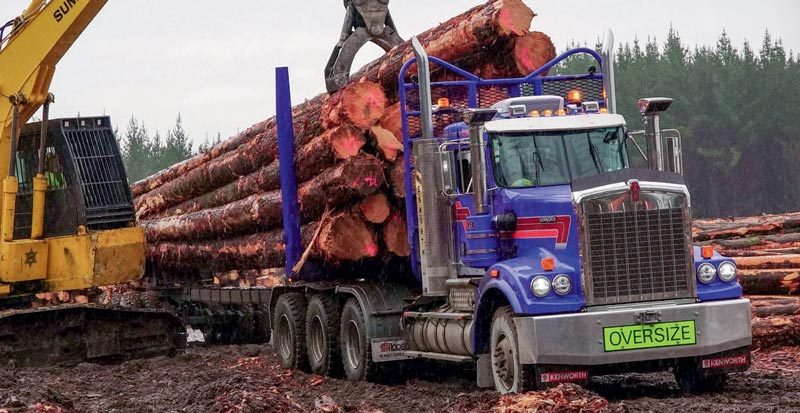
Photo: Again the loading procedure. The big 13R tyres certainly give the 509 a tough and stauch look.
The run to home
Heading back out to the Low Level, it‘s a short one this time that will allow Dunks to finish his shift on time at about 1pm and swap with shift buddy Alex Tapsel. We‘re heading for a gang on Kiorenui Road off Taupiri Road, about a 30km round trip from the Webb. The C509 might be a beefed-up brute in the load carrying department, but remarkably normal in the load powering department. A Cummins X-15 set at 448kW (600hp) delivers 2779Nm (2050lb/ft) of torque to the rear ends. Between the engine and triple drive setup is an Eaton Roadranger RTLO22918B manual transmission. After that things get a little more abstract. Front axle is a Meritor MFS73 rated at 7300kg on multileaf springs, and out back Meritor RZ78-188 axles with diff-lock and cross-locks rated at 35,300kg and 4.89:1 final drive, perched on Neway AD378/10 Extra Heavy Duty Air suspension rated at 38 tonne. Bryan runs the trucks for a little over a million kilometres, saying that by that time they‘re generally getting tired and reliability will likely become an issue. “Again,” he says, “it‘s so driver dependent.” We arrive at the skid and Dunks needs to back up and jackknife a tad to get the big girl in and lined up, before the loading ritual recommences. It gave us time to focus on the Patchell Industries Ultimate stem trailer. It‘s a fascinating looking piece of kit because on the one hand it‘s, well, basic as buggery, but it‘s way cool at the same time. Built like a blacksmith‘s anvil in terms of resilience to the task, the Ultimate is the culmination of two decades of development (see sidebar), and its bones have been pretty much unchanged now for 10 years. Essentially a kickarse chassis, and a canny double walk-beam, double pivot, tapered rubber bush suspension support a turntable/slew ring rated at 50 tonne. The truck and trailer bolsters are mounted the same way, each on slew rings; the bolsters locate via large heavy-duty tapered rubber bushes.
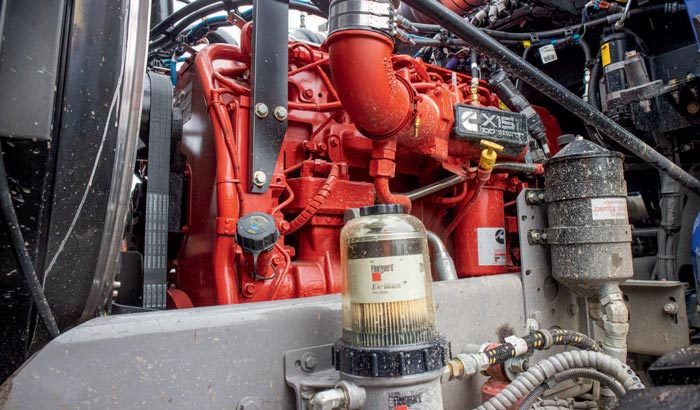
Photo: “Mate! She‘s a pretty big job.” “You‘ll be right.”
The bolster configuration is called the Resilient Mounting setup, on account of its brute strength, with a little give when required. Obviously, being a pole trailer, the load versus vehicle dynamics need to be accommodated. At the front end of the main pole there is a 3m-long round insert commonly known as a ‘pecker pole‘ that extends and retracts in Teflon bushes as the trailer corners, and rotates about its central axis as the rig motors through irregularities in the road surface. For the non-loggers and younger ones reading, on a longs unit when all is going well, it‘s the load that holds the trailer to the truck, not the pole. The pole is locked and becomes the drawbar when empty, but when loaded it has to slide. The Patchell Ultimate log trailer. Simple! Strong! Reliable! Oh, and don‘t let it run over your foot … just saying, it weighs north of seven tonne with the pole. Loaded again and back we went. On highway at speed the front bias loading of the stems certainly influences the rear of the tractor at times. It‘s a seat of the pants feel in the corners, you can certainly feel the rear suspension working and the load trying to bully the show from the rear. There‘s no doubt operating a stems truck is its own thing. Yes, they‘re not necessarily the biggest out here in terms of gross tonnage, but their loading brings its own challenges. Trundling along we had a chance to look around the cab. It‘s a snug hut, and has been on the C509 since 2013 when the cab got a major makeover that included more room, a windscreen redesign, and new dash layout. In terms of dimensions it‘s the direct blood descendent to the narrow Kenworth cabs of yesteryear. There‘s no doubting its build quality and fitout and everything certainly falls comfortably to hand in this no-nonsense workplace, void of frivolous trinkets like infotainment. The SLL 509s are in deepbuttoned ‘Crimson‘ (what happened to Oxblood? Is that not PC any more?) with black trim. The fact that all the drivers making the transition out of the Western Stars lamented the lack of width is a sure sign that K‘dub‘s fantastic 2.1-metre house can‘t come quick enough to its ‘bigboppers‘.
Another interesting aspect was the ride. On highway there‘s no issue. These trucks are slightly shorter in the wheelbase than the Stars in an effort to get more weight on the trailer, but both Dunks and Glenn thought at this early stage the ride over the rough stuff was not as good as the Western Star. A couple of times with Dunks he buttoned off when the going got rutty or corrugated underfoot, commenting that in the Star he wouldn‘t have felt that. It‘s interesting, because one of the big things on the option list that sets the C5 prefixed Kenworths apart from their stablemates is the famous slipper front end suspension. Although it‘s intended for 8.2- tonne front axle applications, its big-ticket item among the road train set is its ability to ride effortlessly over the roughest ruts and corrugations. Essentially, the front axle is located by tramp rods, allowing the front of the spring pack to move fore and aft in a hanger box. This allows significantly more up/down travel. In the stem application, the front axle loading is rarely north of 6.5 tonne so multi-leaf springs cope easily in terms of weight, but there was no doubting the harsh reaction causing Dunks to come off the gas and seek a less volatile line was emanating from the front. It might be worth investigating in future trucks. Our understanding is the price premium for the slipper is not end of the earth stuff.
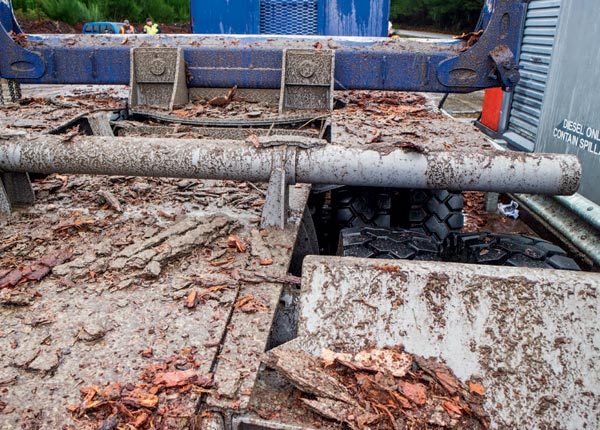 |
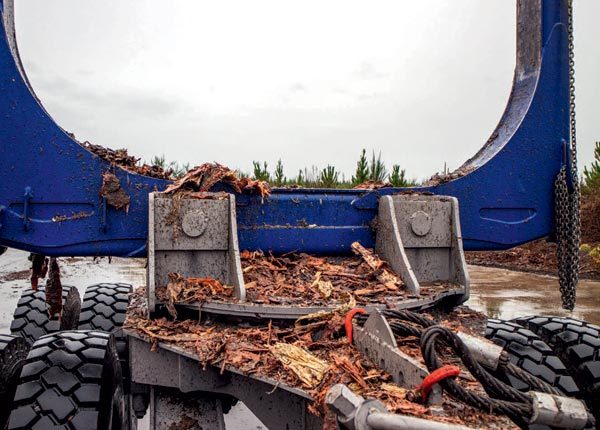 |
| Truck and trailer bolsters mounted via heavy-duty tapered rubber bush on on slew rings. | |
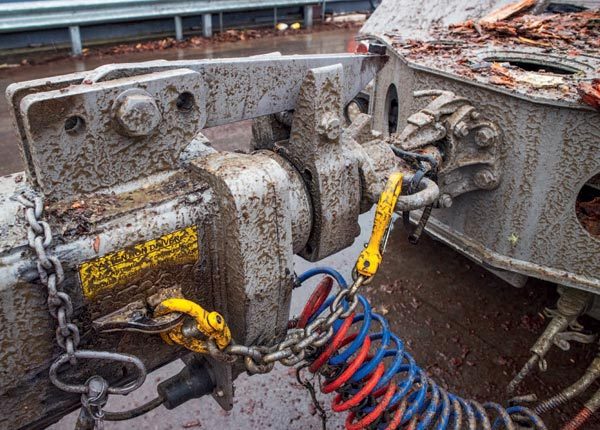 |
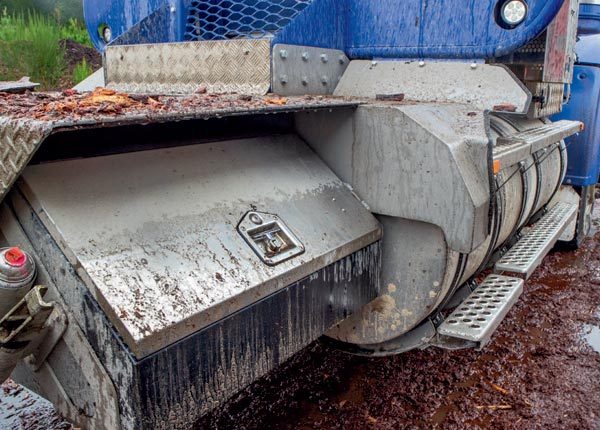 |
| The trailer‘s connection to the truck. Note the sliding, rotating ‘pecker pole‘, locked for empty running. | Armour plating above, big threads out back. |
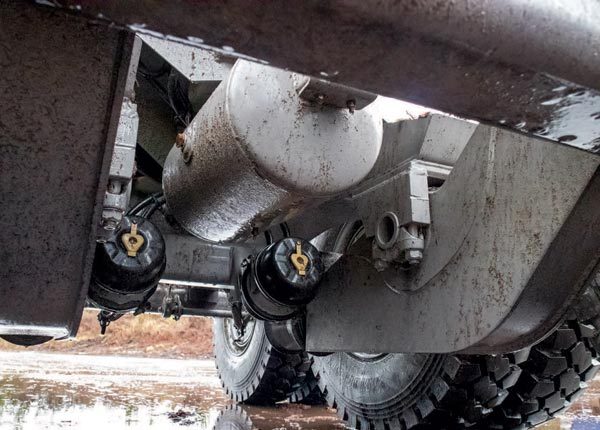 |
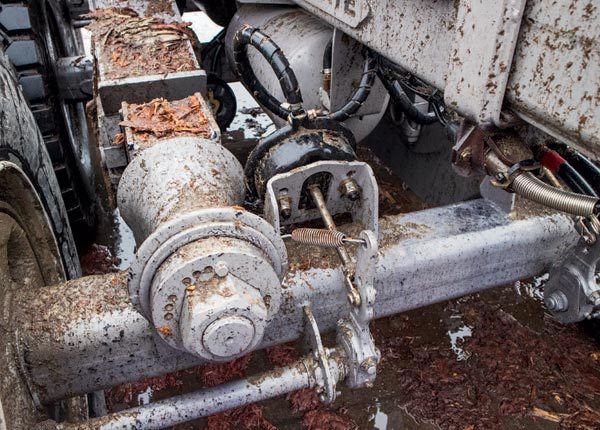 |
| Hefty double-pivot Tridem under the Ultimate‘s chassis. | |
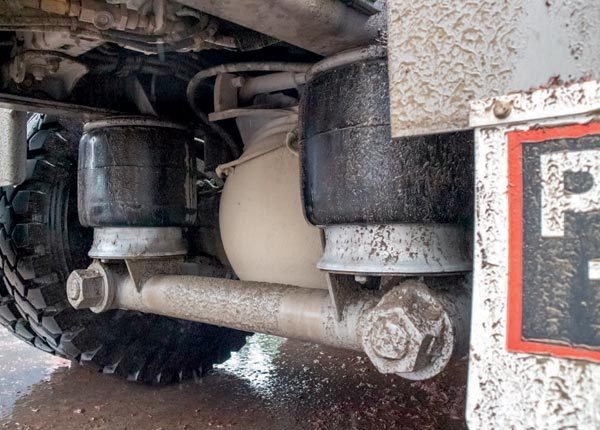 |
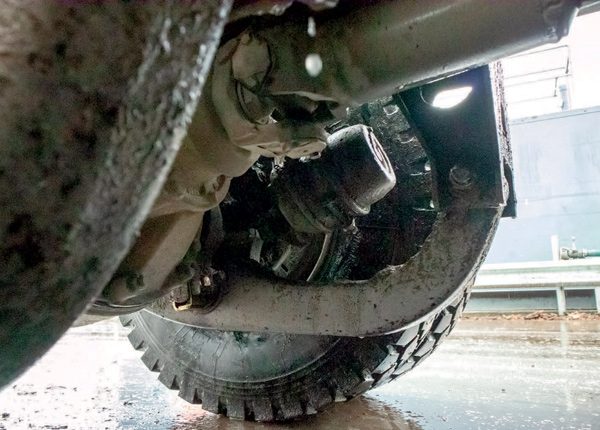 |
| Armour plating above, big threads out back. | |
Day‘s end
The only thing you can really say is, amid life‘s chaotic reality, it does deliver many golden days. Today was one. A C509 stem unit in the Kaingaroa is a special thing, and spending the day with man and machine a cathartic experience. In terms of the machine, if you want to haul big weight in a tough place, then Kenworth‘s C509 is the gig. It‘s a timeless device with nothing to prove, and although aspects of it wait patiently for their development cycle, PACCAR in Australia knows such development must be on the nail; there‘s no second chance. Damaging the truck‘s reputation and history via a penny pinched here, or a flitch missed there, is unacceptable. Customers stump up for this thing for one reason only, and it ain‘t Apple CarPlay. Then there‘s the rest. If it‘s logs you‘re wanting to cart on the back, there aren‘t many stops to make in New Zealand when looking, and Patchell Industries will be among the first calls. The product has been through the refiner‘s fire, and like Self Loader Logging Ltd, the name on the gate still turns up most days to ensure the product bearing his name is worthy. But there‘s so much more to this giant green piece of New Zealand heartland. More to learn. Not just about speccing and building trucks and trailers to haul big loads, and then how to drive them, but about the unimportance of haste, the value of time, patience, and community. The ingredients needed to grow a forest are the same as those required to flourish within it, and Dunks Herewini, Bryan Smith, Ian Patchell, and the Sargisons for that matter, are all proof of that. One thing‘s for sure. At this time in history, Kaingaroa and its people have much to teach us all.
MORE MAIN TEST READS BELOW..
Straight and true
He may not have spent his entire life behind the wheel of a Kaingaroa off-highway log truck, but 52-year-old Duncan ‘Dunks‘ Herewini is every inch a man of Kaingaroa. One thing trees and people have in common is grounding, and if their roots are in solid ground there‘s a high likelihood both will end up straight and true. If you‘re talking a grounding in offhighway logging, the young Dunks had plenty to draw on, having been born and raised in Kaingaroa‘s log truck epicentre, Murupara, and being the nephew of Vern Higgins. Neither was he short on work ethic; proven by the fact Dunks has spent more than two decades of his working life as tyre man to the logging industry. Anyone who knows anything will willingly say that those who earn a living via a fleet tyre truck generally earn every penny. “I‘ve done them all,” he says. “From the smallest runabout to the biggest wheel loader.” Growing up, he said he was always around the truck yard at Murupara. Finding his feet as a young fellow he eventually got a job as a ‘fleety‘, working for Paul Robinson at Wheelers tyres in Edgecumbe, servicing the Murupara yard under boss Barry Lane. “That‘s where I really got introduced to all the owner-drivers. Back then they were all owner-drivers. I drove the trucks around the yard when I did the tyres. They trusted me, and said, ‘keys are in it Dunks, do your job and park it up‘.” Having gained work experience it was off to Australia to do a stint for Bridgestone, before returning home to Beaurepaires in Taupo. “I learn best with my hands. Show me what you want done and how you want me to do it, and I‘ll pick it up straight away. I‘ve taught heaps of new fleeties over the years.” It was while at Taupo that Dunks met Bryan Smith, and operations boss at the time Darren Sinclair. “I‘d had enough and said I was quitting; I‘d just done enough tyres you know? Darren said ‘Are you finishing Dunks? Can you drive a truck?‘ I said ‘Yes, but I‘ve never done it for a job, but I‘m willing to learn. I don‘t have my trailer licence either‘. ‘That‘s no problem‘, he said. ‘We can fix that‘.” Fix it they did.
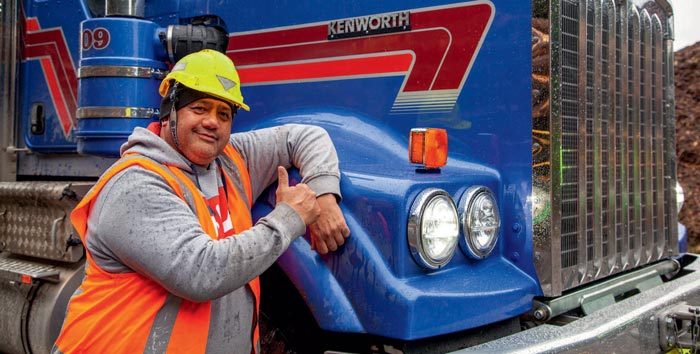
Photo: The right truck and well on his way. Loading the 8×4 525 MH.
Bryan and Darren recognised good root




